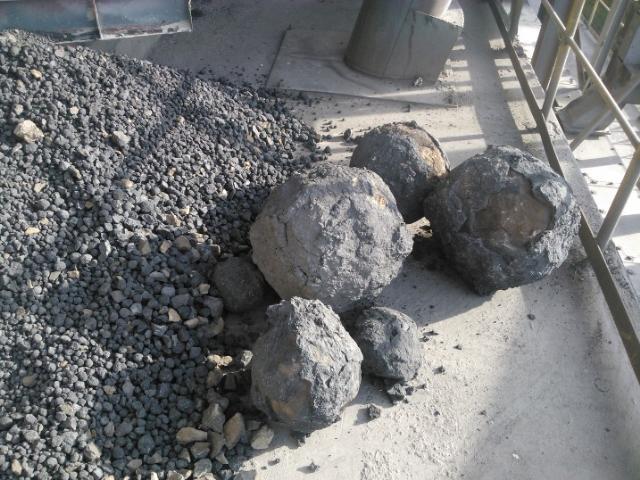Dear sir
We're facing a problem that lead to stop the kiln. Too many big ball clinker form in operation. So what is the reason? might be the low of AM or the fineness?? I also enclose some pics, you could see it, thanks!

Hello PhanMinh,
I notice what looks like some brown, underburnt lumps in the clinker pile near the boulders, and that some of the boulders have a yellowish-brown colour under a dark coating of clinker. Have you broken open any of the boulders to see if the centre is soft burnt or hard burnt?
This could telll you a lot about the origin of the boulders.
Regards,
Ted.
Hi Ted
we have no problem with the free lime (~1.0) and volatility (~0.8) in operation but the yellowish-brown color under a dark coating clinker might associate that the liquid phase was form too soon, right?
We’re using 3c coal mix 30% Indo coal which have about 22% volatile, the fineness of fine coal is under 4% (R90). Volatility (1 – SO3clinker/SO3 hotmeal) is about 0.81.Three days ago we start using about 7% black limestone feeding dircetly to the raw mill (chemical composition below)
| Moi | Loi | SiO2 | Al2O3 | Fe2O3 | CaO | MgO | SO3 | K2O | Na2O | P2O5 | TiO2 | Cr2O3 | Mn2O3 | ||
| % | % | % | % | % | % | % | % | % | % | % | % | % | % | ||
| Tue, 19/06/2012 | Black lime_D | 0.6 | 40.85 | 7.56 | 3.90 | 1.78 | 41.84 | 3.11 | 0.39 | 0.22 | 0.01 | 0.020 | 0.280 | 0.04 | 0.28 |
| Black lime_T | 0.3 | 43.33 | 5.76 | 1.45 | 0.61 | 46.19 | 1.98 | 0.36 | 0.16 | 0.00 | 0.000 | 0.110 | 0.06 | 0.11 | |
| Black lime_N | 1.0 | 39.25 | 5.74 | 2.78 | 1.45 | 37.58 | 10.82 | 1.90 | 0.25 | 0.02 | 0.010 | 0.170 | 0.04 | 0.17 | |
| Black lime_B | 4.3 | 35.35 | 14.04 | 8.44 | 4.42 | 30.87 | 4.99 | 0.78 | 0.30 | 0.01 | 0.05 | 0.73 | 0.01 | 0.73 | |
| Average | 1.5 | 39.7 | 8.3 | 4.1 | 2.1 | 39.1 | 5.2 | 0.9 | 0.2 | 0.0 | 0.0 | 0.3 | 0.0 | 0.3 | |
There are some parameters :
|
|
R90 |
R200 |
LSF |
SR |
AR |
SO3 |
SO3/Alk |
|
Raw meal |
13 - 15 |
0.4 – 0.6 |
103 - 105 |
2.46 |
1.2 – 1.3 |
0.11 – 0.16 |
0.5 – 0.8 |
|
Clinker |
|
|
94.5 – 96 |
2.46 |
1.32 |
0.41 |
|
|
Hot meal |
|
|
|
|
|
2.15 |
|
So I think we have to change some parameters, we might decrease the fineness (14 – 16%) or stop using the black limestone ?? any help!!thanks!
Regards
Hello PhanMinh,
Here a re a couple of points I have noticed from that information;-
1. Black limestone is usually black because it contains occluded carbon, this may be enough to change the thermodynamics of the preheater/kiln system resulting in higher temperatures earlier in the kiln.
2. The black limestone is quite high in MgO. MgO contributes directly to the liquid phase and is also known to reduce the liquid phase viscosity. Significant increases in MgO in kiln feed have been reported by some to increase the occurrence of balls and boulders in the kiln, although I have never actually seen any evidence of this phenomena myself.
3. Your clinker AR is fairly low as well as being very close the the point of maximum liquid phase with respect to AR, which is 1.38. This means that your liquid phase quantity is chemically maximised with respect to Al2O3 and Fe2O3. Because of this, relatively small changes in AR and/or temperature could cause large changes in liquid phase quantity. This could make the burning zone unstable and prone to formation of these balls. Also the low AR (1.32) means that your liquid phase has a fairly low viscosity which could also be contributing to this balling issue.
Suggestions to trouble-shoot the problem;-
1. Try going back to the old limestone and see if that helps the balling problem. You may have to stay on the old limestone for a week or two to fully test the effect on the kiln.
2. To reduce the quantity of liquid phase in the burning zone you could try;
(i) Burning the clinker a bit softer. ie lower the burning zone temperature and aim for slightly higher clinker free lime of say 1.5 - 2.0%
(ii) Increasing your SR from 2.4 to say 2.6.
3. To increase the viscosity of the liquid phase you could increase your AR. say from 1.32 to 1.5.
If you decide to do any of these things, I would suggest that you only do one change at a time rather than all at once. This way you can determine the relative effect of each one individually.
Hope this helps...
Regards,
Ted.